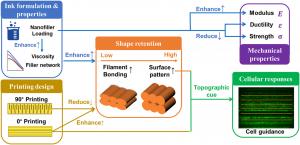3D printing of Bioactive Implants: Engineering the Interplay of Materials and Design
GA, UNITED STATES, September 18, 2025 /EINPresswire.com/ -- This study shows how the interplay of ink composition and printing design shapes the structure, strength, and bioactivity of 3D-printed bone implants. By adjusting these factors, researchers achieved implants that better guide bone cell growth while maintaining stability, advancing personalized treatment for bone repair.
In a new study published in Biomedical Technology, a new 3D printing approach that could transform the way surgeons repair damaged bone was reported. The study shows how adjusting both the printing ink and the way material is laid down can change the strength and healing potential of implants. The researchers used a technique called direct ink writing, which works at room temperature to print dense, solid implants. Unlike many existing 3D-printed scaffolds that are porous and fragile, these implants are mechanically stable while still encouraging bone cells to grow and form new tissue.
A key finding was that implants printed at different angles behaved in surprising ways. “In fused deposition modelling, a common 3D printing method, printing filaments in the same direction as the applied force usually makes the implant stronger,” explains lead author Hongyi Chen from University College London. “But with our approach, we found the opposite—implants printed at 90 degrees actually had better strength because the filaments bonded more effectively.”
Further, the researchers added tiny particles of Laponite, a nanoclay, into the printing ink. “These particles made the ink thicker, helping the printed shapes hold their form, while also releasing bioactive ions that encourage bone cells to attach and grow,” says Chen.
Tests showed that implants with higher Laponite content had a 110% increase in stiffness compared to pure polymer implants, and bone-forming cells on these implants showed greater proliferation and mineralization over time.
“What makes this study distinctive is that we didn’t just look at one factor in isolation,” adds Chen. “By examining the interplay between ink composition, printing orientation, structure, mechanical behaviour, and cell response, we could see how design choices at each stage influence the final biological outcome.”
The work highlights a new strategy for creating bone implants that balance mechanical stability with bioactivity, offering potential benefits for areas such as craniomaxillofacial reconstruction and dental bone grafting. The researchers revealed that the next steps will involve exploring porous and more complex designs, as well as testing in preclinical models. If successful, the approach could enable patient-specific implants produced quickly in hospital labs or even at the point of care.
References
DOI
10.1016/j.bmt.2025.100101
Original Source URL
https://doi.org/10.1016/j.bmt.2025.100101
Funding information
Support from the Engineering and Physical Sciences Research Council (EPSRC) Manufacturing the Future programme (no. EP/N024915/1) to SB for part of this work is gratefully acknowledged.
Lucy Wang
BioDesign Research
email us here
Legal Disclaimer:
EIN Presswire provides this news content "as is" without warranty of any kind. We do not accept any responsibility or liability for the accuracy, content, images, videos, licenses, completeness, legality, or reliability of the information contained in this article. If you have any complaints or copyright issues related to this article, kindly contact the author above.

